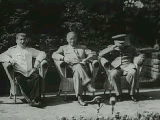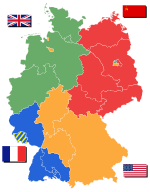Potsdam Conference facts for kids
The Potsdam Conference was a very important meeting held in Potsdam, Germany. It took place from July 17 to August 2, 1945. Leaders from three major countries met: the Soviet Union, the United Kingdom, and the United States.
The main goal was to decide what would happen to Germany after World War II ended. The leaders present were Joseph Stalin from the Soviet Union, Harry S. Truman from the United States, and Clement Attlee from the United Kingdom. Attlee replaced Winston Churchill during the conference.
This meeting followed an earlier one called the Yalta Conference. However, many things had changed since Yalta. The US had a new president, Harry Truman, who was tougher on Communism than the previous president, Franklin D. Roosevelt. Also, Winston Churchill was replaced by Clement Attlee as Prime Minister of the UK. Stalin, who had been in power for a long time, saw himself as more experienced than these new leaders.
Stalin also caused problems because he didn't follow agreements made at Yalta. For example, the Allies had agreed that Poland should have a neutral government. But Stalin had replaced Poland's neutral leaders with ones who would obey him. These issues made the Potsdam Conference very difficult.
What the Leaders Agreed On
During the conference, the leaders discussed many topics. They managed to agree on a few key points:
- Germany would be temporarily divided into four parts, called occupation zones. Each zone would be controlled by one of the Allied powers: France, the Soviet Union, the United States, and Britain.
- A large part of eastern Germany would become part of Poland. Many Germans living there would be moved out.
- People who committed crimes during the Nazi era would be brought to justice.
- Germany's military power would be removed. This meant Germany would not be allowed to have a strong army.
What They Disagreed On
Even though they agreed on some things, there were many topics where the leaders could not find common ground:
- They disagreed on the exact way to divide Germany.
- They couldn't agree on how much money Germany should pay to the countries that won the war.
- The way Stalin was treating Poland was a major point of disagreement.
- They also argued about how much land Poland should receive.
Related Topics
Images for kids
-
A conference session including Clement Attlee, Ernest Bevin, Joseph Stalin, Vyacheslav Molotov, William D. Leahy, Joseph E. Davies, James F. Byrnes, and Harry S. Truman
-
From left to right, first row: General Secretary Joseph Stalin; President Harry Truman, Soviet Ambassador to the United States Andrei Gromyko, Secretary of State James F. Byrnes, and Soviet Foreign Minister Vyacheslav Molotov. Second row: Brigadier General Harry H. Vaughan, Truman's confidant and military aide, Russian interpreter Charles Bohlen, Truman naval aide James K. Vardaman Jr., and (partially obscured) Charles Griffith Ross
-
Sitting (from left): Clement Attlee, Harry S. Truman, Joseph Stalin, and behind: Fleet Admiral William Daniel Leahy, Foreign Secretary Ernest Bevin, Secretary of State James F. Byrnes, and Foreign Minister Vyacheslav Molotov
-
The Oder–Neisse line (click to enlarge)
-
The Foreign Ministers: Vyacheslav Molotov, James F. Byrnes, and Anthony Eden, July 1945
See also
 In Spanish: Conferencia de Potsdam para niños
In Spanish: Conferencia de Potsdam para niños










